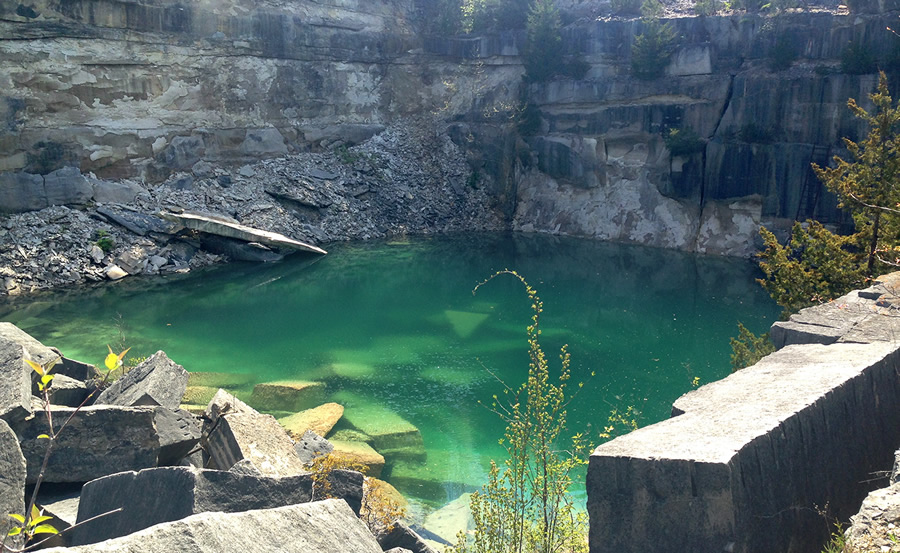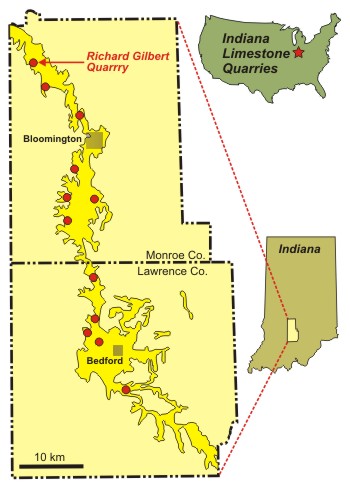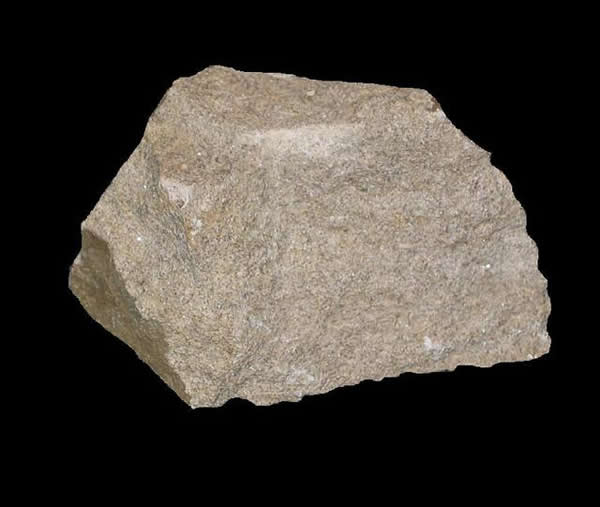Indiana
State Stone: Limestone
IC 1-2-9-1
Sec. 1. The regal type rock "Limestone" which is found and quarried in south and central Indiana from the geologic formation named the Salem Limestone, is hereby adopted as the official stone of the State of Indiana.
(Formerly: Acts 1971, P.L.3, SEC.1.)

Salem Limestone quarry. Photo by Teal Strabbing courtesy of VisitIndiana.com.
Limestone is one of the main sedimentary rocks, along with sandstone and shale. Limestone is often formed from the carbonate shells of aquatic animal life, since most shelly animals makes their shells out of a variety of carbonates (CaCO3). One of the hallmarks of carbonates is that they react with acid, making limestones fairly easy to identify as a whole. However there are multiple varieties of limestones depending on where there were formed, what their primary mineral is, the size and types of the fossils within the limestone, and what type of cement is present within the rock. These include fossiliferous limestone, coquina, chalk, micrite, crystalline limestone, oolitic limestone, and travertine. Fossiliferous limestone is formed usually on the continental shelf from the large shells of animals like clams and snails cemented together with microscopic calcium carbonate shells, called lime mud. Coquina is typically formed in beach like environments where the number of animal shells far exceeds the surrounding sediment. Although some definitions vary, the typical definition is that coquina is made up of loosely cemented shells with little to no matrix (cement). Chalk is formed from the compaction of microscopic plates called coccoliths, which come from animals called coccolithophores. Chalk is similar to fossiliferous limestone except the rock is typically all white and contains only one type of fossil. Micrite is comprised primarily of lime mud, like a fossiliferous limestone without the fossils. It forms a little further out from the shoreline than fossiliferous limestone where the mud can float out in the water but is generally too deep for shelled animal life. Crystalline limestone is an inorganic type of limestone that usually forms in shallow lagoons or lakes. The water in the lagoon becomes saturated in calcite and then the water starts to evaporate causing calcite to precipitate out of the rock. This is common where water is periodically added to a lagoon or a lake after a lot of calcite is precipitated out. It is also found when other types of limestone are altered in some way. Oolitic limestone is another inorganic type of limestone where limestone mud is deposited along the continental shelf edge and the naturally movement of the water rolls the mud around creating little balls of calcite. These little calcite balls are then cemented together. And the last limestone variety, travertine, is formed in caves from the deposit of calcite along stalactites, stalagmites, and other flowstones. Since the structures are built up layer by layer, this causes the rocks to often have a banded appearance with often a lot of holes within it.

Salem Limestone Quarry locations. Image courtesy of CUNY - Brooklyn College.
Although the State Stone is designated a "Limestone", the official state announcement calls out specifically the Salem Limestone from the south and central Indiana, so we will focus on that limestone in particular. Due to incomplete knowledge of the extent of the Salem Limestone deposits when it was first being quarried, the body currently known as the Salem Limestone has gone through many names throughout history. These include the Bedford stone, Bloomington stone, Ellettsville stone, Salem stone, White River stone, Bastard stone, Bedford Marble, Gosport Stone, Indiana Oolitic Stone, Spergen fossil bed, Bedford Oolitic Limestone, Spergen Hill Limestone, Spergen Limestone, Salem Formation, and the Indiana Limestone (of which it is known today in the building-stone trade).

Salem Limestone. Image courtesy of earthphysicsteaching.homestead.com.
The Salem Limestone is a Middle Mississippian age (335-340 million year old) light-grey to bluish-grey pure calcarenite limestone that crops out between Bloomington and Bedford in the south-central portion of Indiana. It formed in a shallow sea that straddled the equator at the time. Wave action broke up the largest particles creating a limestone that consisted mostly of smaller fossil fragments. This wave action also produced quite a bit of cross-bedding throughout the deposit as well. Quarrying of the stone began in 1827 and has continued up to the present day with nine different quarries all mining the same formation. Indiana Limestone is a "freestone", which means that there is no preferential cracking, jointing, or splitting. This also means that blocks of the limestone can be planed, hand-worked, or otherwise manipulated without fear of the rock breaking in a preferential direction. The limestone is 97% pure calcite with microscopic foraminifera and bryozoan fossils found throughout. Other fossils that can be found in limited quantities include gastropods, pelecypods, brachiopods, and crinoids. The Salem Limestone has been used as a building stone in many famous projects across the country including the Lincoln Memorial, the Thomas Jefferson Memorial, Grand Central Station, Ellis Island, the Empire State Building, The Pentagon, and 27 U.S. state capitol buildings. This abundance of use and it's beautiful appearance has made this "The Nation's Building Stone".
References
https://statesymbolsusa.org/states/united-states/indiana
https://books.google.com/books
https://igws.indiana.edu/compendium/salem-limestone
https://igws.indiana.edu/bookstore/details.cfm?Pub_Num=OP38
http://earthphysicsteaching.homestead.com/Limestone.html
Geology of Indiana's National Parks
Through Pictures
(at least the one's I have been to)
Visited in 2008
We had initially visited this park when it was still Indiana Dunes National Seashore. And since we had the dogs with us while we were moving across country we were limited on where we could go. But this seemed like a nice park to let them get out and run around for a bit. At the time I wasn't also taking geologically themed photos, so these are what I have.
Walking down to the lakeshore. Indiana Dunes sits at the southern extent of Lake Michigan, the third largest Great Lake, and the sixth largest lake in the world. Lake Michigan and the surrounding landscape was a product of glaciation. Glaciers are like giant bulldozers made of ice and snow. During the last Ice Age, over 10,000 years ago, glaciers had come through and plowed out the basin in which Lake Michigan now sits. Eventually the weather got too warm for the glaciers and they started to melt. At that point, the glaciers start acting like conveyor belts, transporting rocks, soil, sand, boulders, and anything else that gets in their way to the end point of the glacier. Here all that debris gets dumped into one giant pile known as a moraine. The material within the pile is called till and is composed of all the glacial debris with a large amount of clay produced by the grinding action of the glacier. Towards the end of the Ice Age, as the glaciers started to retreat, they formed a moraine near the southern tip of Lake Michigan called the Valparaiso Moraine. Before there was Lake Michigan though, there was another lake. Lake Michigan formed from glacial Lake Chicago, a lake roughly the same shape as Lake Michigan but the water level was much higher. Lake Chicago formed about 12,000 years ago and was dammed to the south by the Valparaiso Moraine along the northern edge of Indiana.
As Lake Chicago slowly dwindled down to the present day Lake Michigan about 2,000 years ago, several lakeshore benches were cut into the moraine at different elevations. The present lake level is at 580 feet above sea level, while there are lakeshore terraces located at 605, 620, and 640 feet above sea level. Much of the sand that forms Indiana Dunes comes from reworking of the Valparaiso Moraine. Walking towards the shore you come across this large flat area before descending abruptly to the beach. This large flat area is the last lake level of Lake Chicago before it lowered to the present day Lake Michigan levels. This is the 605 feet above sea level beach terrace known as the Tolleston stage. The Tolleston stage of Lake Chicago lasted from 8,000 to about 2,000 years ago.
We are getting excited for our beach trip, looking out from the edge of the Tolleston stage terrace.
On the slope down from the Tolleston stage terrace to the modern day Lake Michigan. The sand dunes built up over time along all the stages of Lake Chicago as well as the modern day Lake Michigan. The sand, much of it reworked glacial deposits, are moved about the shore by a couple of processes. Winds are able to pick up the sand and blow them across the beach surface to accumulate behind the beach, also known as the foredunes. The foredunes are just above high tide levels of the water that would erode away much of the sand accumulation. Longshore currents also move sand along the beach. The longshore currents are currents that move parallel to the shore. These currents travel east to west and carry sand deposited from up-current river deltas and replenish any sand lost during the year from storm activities or other natural erosional events.
One of the major features of dunes that prevents them from continually being destroyed during storms and high winds are the grasses that grow on them. These fast growing grasses act as anchors as well as wind baffles that end up not only preventing sand from being blow away but actively promote dune growth. The baffle slows the wind down, causing whatever sand the wind is carrying to drop out.
Here, with a view along the lakeshore itself, you can see the foreshore dunes off to the left with their rather significant slope up to the lake terraces. You can also see the disparate sizes of the sediment along the foreshore of the beach. Here the larger sized sediment is located along the water-beach interface, This is because the finer sand size particles are either blown further up-beach or carried back out into the lake by larger waves.
You can see the rather course sediment along the shoreline pretty well here. Much of this coarser sediment would have been brought here with the glaciers from further up north, mostly from Canada. Then the sediment would have been reworked by stream and lake water erosion over the last 12,000 years.
References
http://npshistory.com/publications/indu/sr8.pdf
https://igws.indiana.edu/ReferenceDocs/StateParkGuide_Dunes.pdf


